
Senolytic Agents Kill Zombie Senescent Cells
I have written about Senescent cells in the past. I have been aware of senolytic agents for a few years now. Actually, I wrote a blog about this back in 2017 which can be found here (https://stemcellorthopedic.com/possible-new-way-treating-osteoarthritis-senolytic-agents/). I am convinced that senolytic agents will help change the face of regenerative medicine and for that matter most of medicine. More importantly they will dramatically increase success in Regenerative procedures. Let us again discuss senescent cells. These are cells that should have died but did not. There are a number of studies in the field of osteoarthritis and its relationship to senescent cells. Eliminating a portion of these cells may produce significant results! Osteoarthritis is but one disease of aging. There seems to be great promise of senolytic agents in combating degenerative conditions. The following diagram gives us an idea of the damage that these cells can cause.
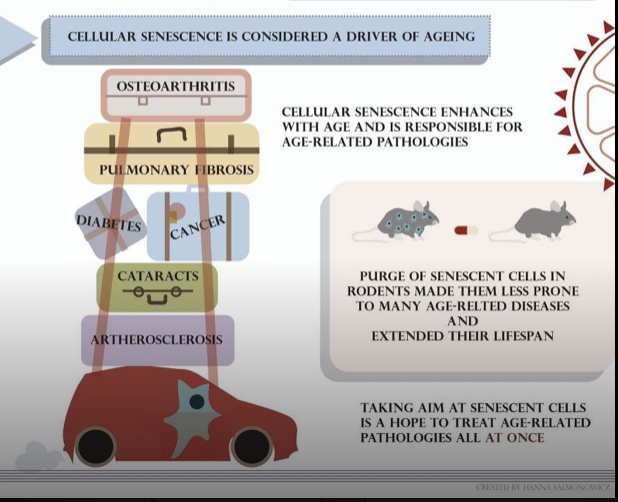
I think we need to look at senescent cells in a bit more depth.
I found an excellent diagram from a site called CellAge
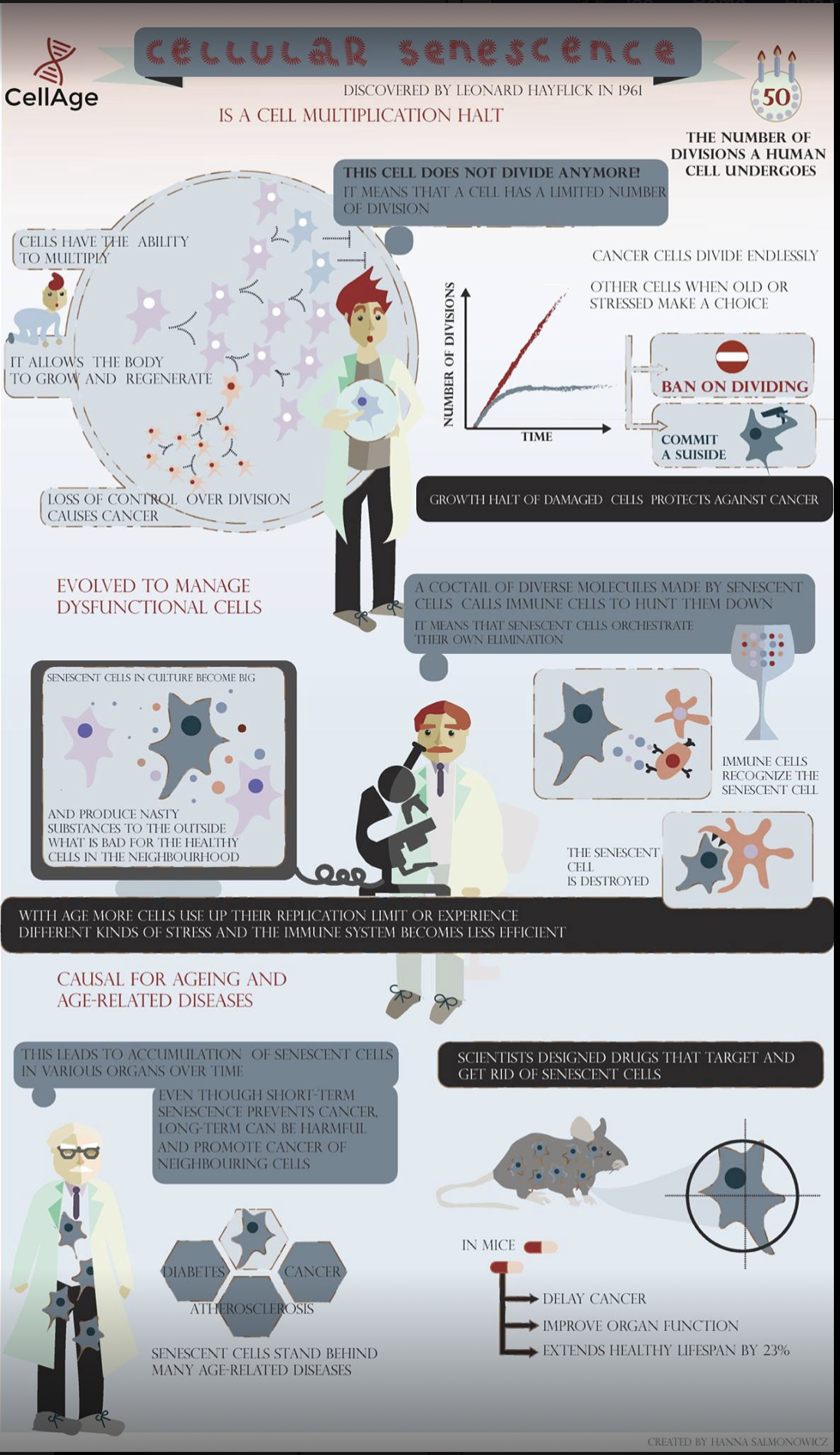
This diagram hits upon the highlights of senescent cells. The essence is that they are producing growth factors that are causing havoc on other neighboring cells.
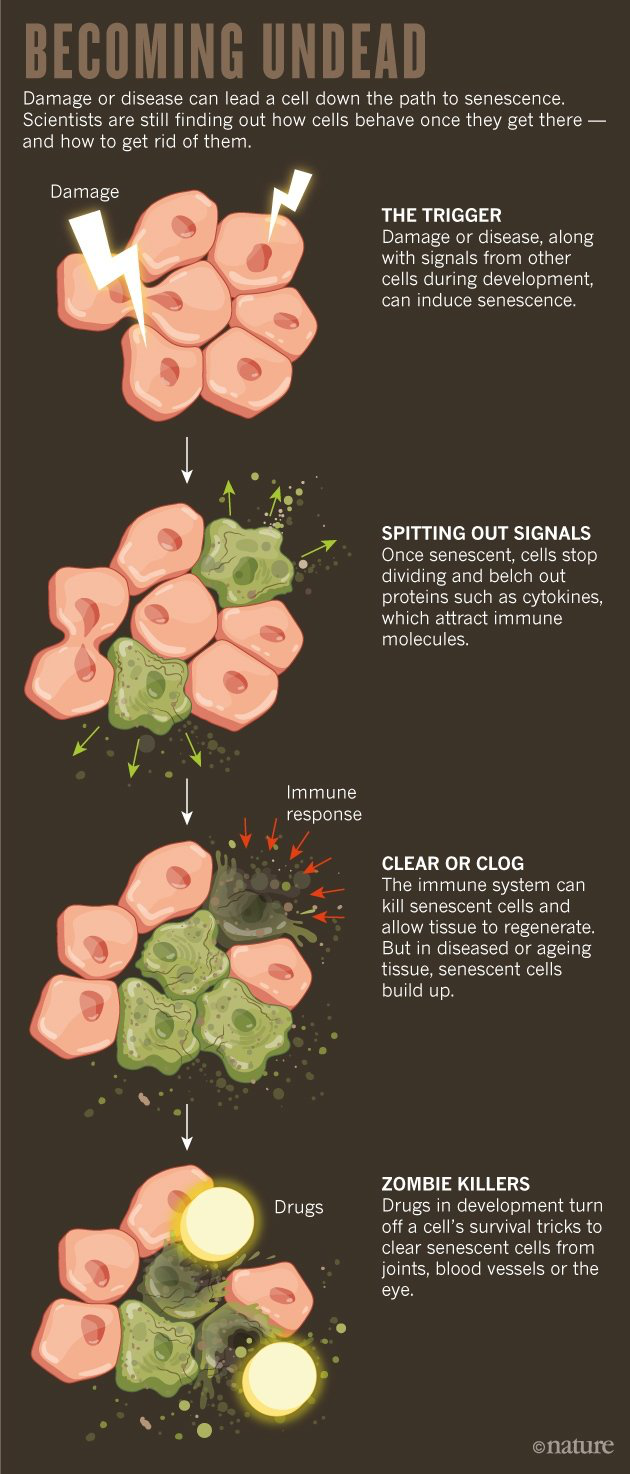
In the proceeding diagram we get a true appreciation of clinical significance of Senescent cells. Once they reach the senescent stage they stop replicating but continue to survive. In the above diagram we see initially the cells have some sort of trigger which causes them to switch to senescence. Once they are in the senescence mode bad things begin to happen. These cells begin to send out signaling molecules called cytokines. These cytokines have far reaching effects. Under normal circumstances the cells of the immune system will attack the senescent cells and destroy them. Actually, these cells will also stimulate a process called Autophagy. Autophagy is an important aging pathway in the body. It is the method that the body will recycle various cellular parts into new cells. Autophagy by itself has significant ramifications in anti-aging and overall health. Eliminating the senescent cells will stimulate autophagy in the right circumstances.
Unfortunately, many times the senescent cells escape detection, they increase in numbers and become like terrorists in our body. They will cause havoc to other cells. Senescent cells look very different from healthy cells. They express different genes, they are prohibited from reproducing or dividing naturally, and they pump out inflammatory “SOS” signals in an attempt to recruit other healthy cells to come to their rescue, usually in vain. These signals include proinflammatory cytokines, chemokines, proteases (enzymes that break down proteins) and other factors that together make up what is called the senescence-associated secretory phenotype (SASP). The inflammation created by senescent cells can lead to tissue dysfunction and even turn healthy cells senescent, like a zombie virus that spreads and eventually causes the zombie apocalypse of late-life frailty and disease. This spreading of cellular senescence may even happen at a distance, with senescent cells in one tissue, like fat, spreading senescence-causing inflammatory signals to cells in another tissue, like muscle. This is why a pendulous belly can be so detrimental to our health.
The agents that go after senescent cells are called a senolytic agents. The breakdown of the word senolytic is as follows: seno refers senescent cells while lytic refers to lysis which means to rupture the cell. So, a senolytic agent is one that kills the senescent cell.
One exciting aspect of our treatment protocols is employing the use of P-53 protein transdermal patch. P-53 in our body is a very potent senolytic agent. unfortunately, it sometimes undergoes a mutation and loses its effectiveness leading to some big problems such as cancers. Another name for the P-53 is “the tumor suppressor gene”. P-53, unlike other agents, can actually repair the cell under the right circumstances. It will analyze the cell and proceed with DNA repair if the damage is not too great. However, if the P-53 determines that the DNA damage is too great it will disable the cell and cause it to go on to death. The P-53 is beneficial in ferreting out senescent cells that may lead to cancers. Unfortunately, as we age the P-53 may undergo mutation and lose its effectiveness. This loss of effectiveness may lead to the development of a cancer. The following diagram shows the P-53 agent in action.
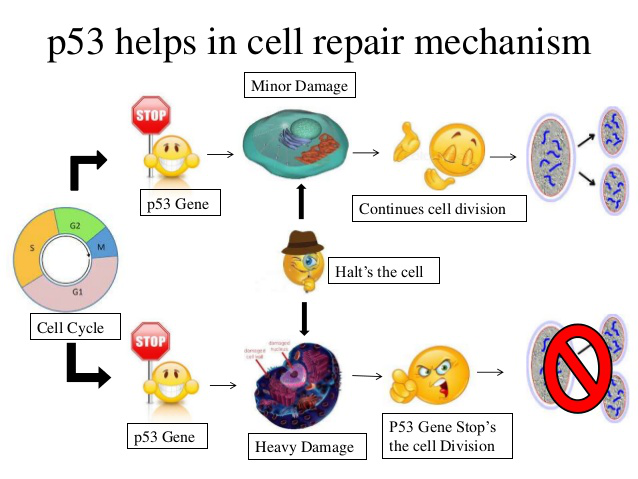
More information on P-53 can be found in a recent blog https://stemcellorthopedic.com/elephants_longevity_p53/ The P-53 patch is quite revolutionary. It is definitely part of our armamentarium in our anti-aging. We have had excellent success with the P-53 patches. However, not wanting to rest on our laurels we want to take the treatment of senescent cells down a second road to use in conjunction with the P-53 transdermal patch.
The next diagram shows senolytic agents in action. We can see when the senescent cells accumulate they wreak havoc causing cancer, aging, osteoporosis, osteoarthritis and a host of other degenerative diseases.
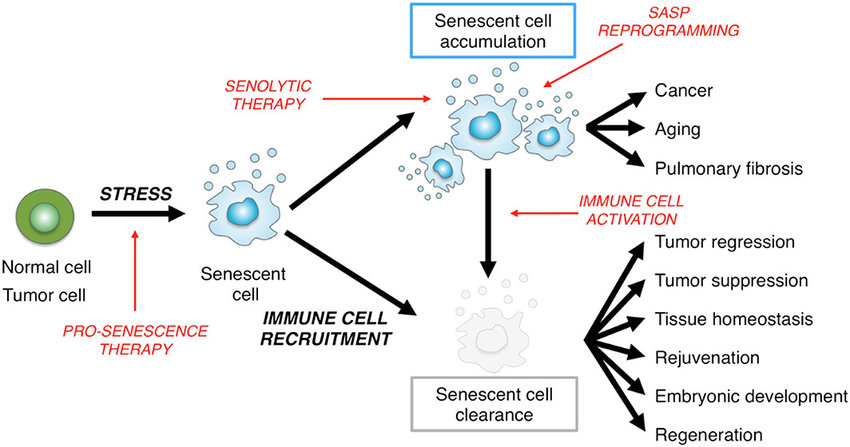
We can definitely see the benefits when the senescent cells are cleared away. We also see that the immune system is instrumental in clearing away the senescent cells. It stands to reason that clearing away these cells will lead to anti-aging and most likely better success in Regenerative Medicine which employs stem cells and other regenerative cells. Senescent cells, however, are not all bad, and evidence shows that they play a role in cellular reprogramming and wound healing. Like all things in biology, it is therefore clearly a question of balance: too much clearance of senescent cells would be bad for wound healing and cellular reprogramming, but too many senescent cells lead to damage.
I would like to present a short article that was recently published concerning the use of Senolytic agents, in this case, in pulmonary disease.
Small pilot study points to feasibility of larger trials in age-related diseases
Senolytics target cellular senescence, a process in which damaged cells, rather than dying, persist and become toxic to cells around them. Cellular senescence has been shown to drive multiple age-related diseases, including idiopathic pulmonary fibrosis (IPF), a chronic, irreversible and progressive disease that results in scarring of the lungs. In animal studies, run by Mayo Clinic collaborators James Kirkland, M.D., Ph.D.; Nathan LeBrasseur, Ph.D., M.S., and Tamara Tchkonia, Ph.D., senolytics selectively cleared these toxic cells in mice that model IPF.
A lethal disease for which there are few options
"IPF is a devastating and progressive fibrotic lung disease with a median survival of less than five years in newly diagnosed adults usually over 60 years of age," said Anoop M. Nambiar, M.D., M.S., associate professor of medicine at UT Health San Antonio and founding director of the university's Interstitial Lung Disease Program, one of 60 Pulmonary Fibrosis Foundation Care Centers in the United States. Dr. Nambiar is co-first author of the research manuscript and enrolled 12 of the patients at UT Health San Antonio and the South Texas Veterans Health Care System.
Despite the current availability of two U.S. Food and Drug Administration-approved therapies that may slow down disease progression in some IPF patients, the prognosis remains poor and is worse than for many common cancers, Dr. Nambiar said. Lung transplantation may be lifesaving, but often is only an option for younger, healthier patients. "There remains a significant unmet need for safer and better treatments for patients with IPF," Dr. Nambiar said.
Patients enrolled in Texas, North Carolina
In this first-in-human pilot study, the investigators enrolled 14 older adults diagnosed with stable, primarily mild-to-moderate IPF. Participants were enrolled at both UT Health San Antonio, which served as the primary patient recruitment site, and Wake Forest medical school, which initiated the trial and served as the study coordinating center. "Though small, this pilot study marks a major breakthrough in how we treat age-related diseases such as IPF," said Jamie Justice, Ph.D., assistant professor at Wake Forest medical school, co-lead investigator and corresponding study author. "Here, we've therapeutically targeted a fundamental biological hallmark of aging that is implicated in IPF, and we show early but promising results for the first time in human patients. This small study represents a major paradigm shift in treatment strategy."
Each participant received two senolytic drugs, dasatinib and quercetin (DQ), taken by mouth for three consecutive days each week for three consecutive weeks (nine doses total). All patients were able to comply with this regimen without any discontinuation of the study drugs.
The research team measured clinical laboratory chemistries before and after DQ administration, and performed rigorous symptom questionnaires weekly of health, quality of life and side effects to obtain preliminary evidence of safety and tolerability. The team also evaluated markers of physical function including six-minute walk distance, walking speed, sitting-to-standing repetitions, a frailty index based on clinical laboratory chemistries, and biological assays of senescence-associated proteins secreted by the toxic cells.
Results
The most consistent improvements following senolytic therapy were observed in participants' mobility. The six-minute walk test, timed sitting-to-standing repetitions and other measures were significantly improved after completion of the treatment. The majority of patients exhibited mobility gains of greater than 5 percent. Other physical function markers, including grip strength and pulmonary function testing, did not change.
"No drug therapies, including the available anti-fibrotic drugs, have ever shown to stabilize, let alone improve, an IPF patient's six-minute walk distance," Dr. Nambiar said. "But in this pilot study of DQ, participants' six-minute walk distance improved an average of 21.5 meters.
"We should be cautious about whether this finding is true based upon this small study without a placebo control group," Dr. Nambiar said. "However, this and other results warrant further study in larger randomized, controlled trials."
Preliminary but encouraging
"Cellular senescence is clearly emerging as a main player in aging," said manuscript co-author Nicolas Musi, M.D., professor of medicine at UT Health San Antonio and director of the university's Sam and Ann Barshop Institute for Longevity and Aging Studies. "Previously, no published data existed to demonstrate that drugs targeting cellular senescence could be safely given to older patients, or that they might be used to treat diseases of aging such as IPF. The pilot research we've reported is preliminary but encouraging."
Dasatinib and quercetin are U.S. FDA-approved for other indications. Moreover, they are effective in eliminating senescent cells originating from different cell types.
"This is the same combination of drugs that was shown to improve pathology in animal models of Alzheimer's disease, which our group, including Dr. Miranda Orr at UT Health San Antonio, demonstrated three months ago for the first time," Dr. Musi said.
Side effects did not discontinue the treatment
The most frequent side effects reported after DQ therapy were mild to moderate in severity, including respiratory symptoms such as cough and shortness of breath, and gastrointestinal discomfort or heartburn. Some patients reported skin irritation or bruising related to tissue biopsies obtained for biological measurement purposes.
Limitations and goals
This pilot study has obvious limitations. First, it was small (14 patients), and substantially larger numbers of research participants are needed to definitively evaluate change in biological markers of cellular senescence. In addition, the study did not enroll a control group of IPF patients who took a placebo rather than the senolytic. "Therefore, any improvements in physical function should be interpreted with caution and require further study," Dr. Nambiar said.
Materials provided by University of Texas Health Science Center at San Antonio. Note: Content may be edited for style and length.
What we gather from this note is that senolytic agents seem to have a very beneficial effect on the senescent cells. Which in turn effects the patient’s health. We should realize that this benefit most likely carries over to all types of senescent cells.
Here is the significance this has on clinical practice. Very few if any doctors, clinics etc are addressing senescent cells. I suspect a good bit of the problem is they are not acutely aware of them and their significance. THIS WILL BE THE NEXT BIG ASPECT OF REGENERATIVE MEDICINE. We are already entrenched in treating senescent cells. We have been utilizing the P-53 patches on some of our patients. Now we are going to take the next step. We have found a source of Quercetin which was fairly easy. The difficult aspect was to find a source of Dasatinib. Luckily, we were successful in this regard. The last piece of the puzzle was figuring out the protocol for dosage regimen. We have now put a very unique protocol together utilizing the P-53 patches, Quercetin and Dasatinib. Typically, the treatment regimen will be one dosage a week for either two or three weeks. Taking senolytic agents for a long period of time can have a detrimental effect on the body. It could actually speed up aging if not done properly. Hence a regimen of only 2 or 3 per year.
Senolytic therapy has not only demonstrated profound rejuvenating properties by itself, but may also help open up opportunities for other rejuvenation strategies to be more effective. It is but one step in our anti-aging protocols. When used with some of our other regimens we feel we have one of the most unique Regenerative and Anti-aging programs around. With time I am sure other progressive clinics will catch on to the topics of senolytic agents. Thanks Dr. P
Source URL: https://stemcellorthopedic.com/senescent-zombie-cells-have-finally-met-their-match-senolytic-agents/
